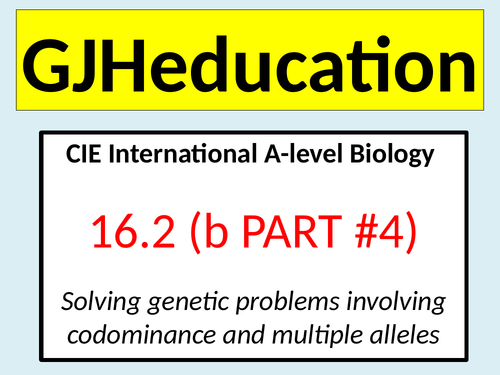




This fully-resourced lesson explores the inheritance of genetic characteristics that involve multiple alleles and codominant alleles. The engaging and detailed PowerPoint and differentiated worksheets have been designed to cover the part of point 16.2 (b) of the CIE International A-level Biology specification which states that students should be able to use genetic diagrams to solve problems which involve codominance and multiple alleles.
The main part of the lesson uses the inheritance of the ABO blood groups to demonstrate how the three alleles that are found at the locus on chromosome 9 and the codominance of the A and B alleles affects the phenotypes. Students are guided through the construction of the different genotypes and how to interpret the resulting phenotype. They are challenged to use a partially completed pedigree tree to determine the blood group for some of the family members and to explain how they came to their answer. To further challenge their ability to apply their knowledge, a series of questions about multiple alleles and codominance in animals that are not humans are used.
All of the questions are followed by clear, visual mark schemes to allow the students to assess their progress and address any misconceptions
Get this resource as part of a bundle and save up to 46%
A bundle is a package of resources grouped together to teach a particular topic, or a series of lessons, in one place.
Topic 16: Inherited change (CIE A-level Biology)
Meiosis, genetic inheritance and the control of gene expression are some of the harder topics on this A-level Biology course and all three are covered in topic 16 (Inherited change) of the CIE A-level Biology specification. The 10 lessons included in this bundle have been planned at length and contain a wide range of tasks that cover the detailed content whilst checking on understanding and key terms and values are introduced through engaging quiz competitions. The following topic 16 specification points are covered by these lessons: Topic 16.1 * The meaning of a homologous pair of chromosomes * The behaviour of chromosomes in animal and plant cells during meiosis * Genetic variation is caused by crossing over, random assortment and the random fusion of gametes at fertilisation Topic 16.2 * The meaning of key genetic terms * Using genetic diagrams to solve problems involving mohohybrid and dihybrid crosses, including those involving autosomal linkage, sex linkage, codominance, multiple alleles and gene interactions * Use the chi-squared test to test the significance of differences between observed and expected results * Gene mutations occur by substitution, deletion and insertion and may affect the phenotype Topic 16.3 * The genetic control of protein production in a prokaryote as shown by the lac operon * The function of transcription factors in gene expression in eukaryotes * Gibberellins and DELLA protein repressors If you would like to sample the quality of the lessons included in this bundle, then download the autosomal linkage and chi-squared test lessons as these have been uploaded for free
Topic 16.2 [b]: The roles of genes in determining the phenotype (CIE A-level Biology)
Each of the 5 lessons within this bundle are fully-resourced and cover the content of point (b) of topic 16.2 of the CIE A-level Biology specification which states that students should be able to use genetic diagrams to solve problems which involve the following: * monohybrid and dihybrid crosses * autosomal linkage * sex-linkage * codominance * multiple alleles * gene interactions Students are guided through the construction of the genetic diagrams for the inheritance of one or two genes and are shown how to analyse the phenotypic ratios to determine whether linkage has occurred or whether a gene interaction is involved. The wide range of activities which includes exam questions with visual mark schemes, differentiated tasks and quiz competitions will maintain engagement whilst providing the students with opportunities to assess their progress against the current topic
Something went wrong, please try again later.
This resource hasn't been reviewed yet
To ensure quality for our reviews, only customers who have purchased this resource can review it
Report this resourceto let us know if it violates our terms and conditions.
Our customer service team will review your report and will be in touch.